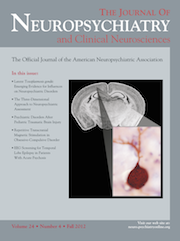Tramadol Precipitating Serotonin Syndrome in a Patient on Antidepressants
To the Editor: Tramadol is a synthetic analog of codeine. It is a commonly prescribed analgesic because of its relatively lower risk of addiction and better safety profile as compared with other opiates. Its action is mainly targeted at the central μ-opioid receptors; however, it also inhibits serotonin and norepinephrine reuptake at the peripheral level.1 It is structurally similar to venlafaxine2 and accounts for a significant number of drug interactions among patients using antidepressants.3
We report a 62-year-old Caucasian man with a major depressive episode currently in partial remission on citalopram 40 mg and bupropion 150 mg twice a day. The patient had a recent visit with his primary care physician and was started on tramadol 50 mg three times a day for musculoskeletal pain. Three day after being started on tramadol, the patient presented to the emergency department with tremors, diaphoresis, and anxiety. He denied excessive use of any of his medication and denied any recent illicit drug use. Further examination revealed tachycardia, elevated blood pressure, and presence of clonus in the lower extremities. The patient was diagnosed with serotonin syndrome based on the triad of mental status changes, autonomic hyperactivity, and neuromuscular abnormalities. He was admitted to the intermediate care unit for further monitoring. Medications, including citalopram, bupropion, and tramadol, were discontinued, and supportive care was provided. Diazepam was used to help with anxiety, and labetolol was used to reduce the patient’s autonomic instability. The symptoms resolved within 48 hours of admission. Antidepressant medications were restarted at a lower dose and titrated in outpatient care. The primary care physician was educated about the drug interaction, and an alternative analgesic medication was used in the future for this patient.
Serotonin toxicity has been traditionally seen with high doses of serotonergic antidepressants or their combination. However various pro-serotonergic drugs have been implicated in serotonin syndrome if used along with antidepressants, especially in older patients. Tramadol is O-methylated by CYP2D6,4 and SSRIs are known to have an inhibitory effect on CYP2D6.5 This interaction could be responsible for a reduction in tramadol metabolism, leading to the serotonin toxicity seen in our patient. Physicians should be aware and educate patients on the risk of serotonin toxicity secondary to drug interactions with various psychotropic medications.
1 : Tramadol: seizures, serotonin syndrome, and coadministered antidepressants. Psychiatry (Edgmont) 2009; 6:17–21Medline, Google Scholar
2 : Similar effects of tramadol and venlafaxine in major depressive disorder. South Med J 2008; 101:193–195Crossref, Medline, Google Scholar
3 : Antidepressants: prevalence of duplicate therapy and avoidable drug interactions in Australian veterans. Aust N Z J Psychiatry 2007; 41:366–370Crossref, Medline, Google Scholar
4 : Polymorphic CYP2D6 mediates O-demethylation of the opioid analgesic tramadol. Eur J Clin Pharmacol 1997; 53:235–239Crossref, Medline, Google Scholar
5 : Dose-dependent inhibition of CYP1A2, CYP2C19, and CYP2D6 by citalopram, fluoxetine, fluvoxamine, and paroxetine. Eur J Clin Pharmacol 1996; 51:73–78Crossref, Medline, Google Scholar



